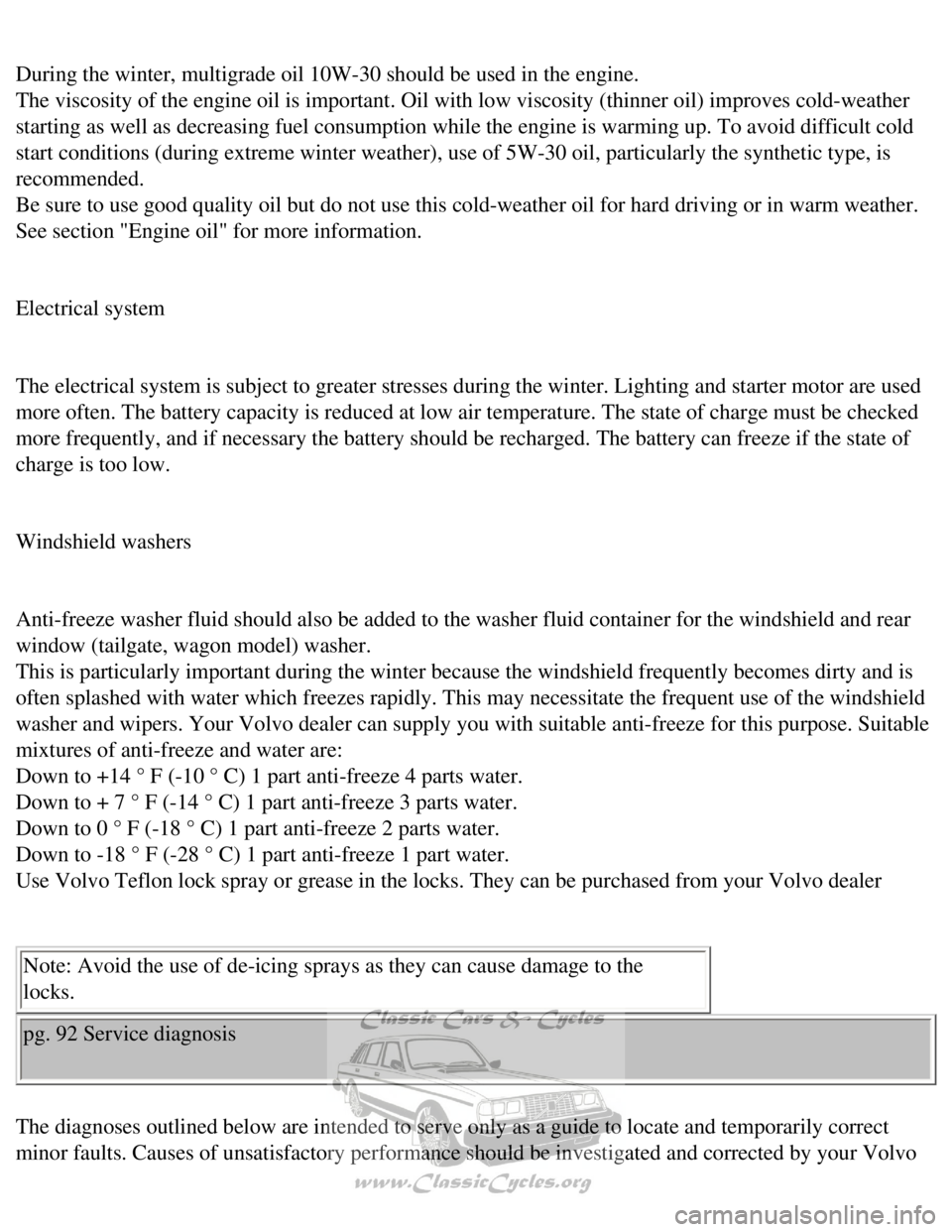Page 117 of 143

Volvo 1990 240 Model
Polishing (waxing)
Normally, polishing is not required during the first year after delivery\
. Waxing may be beneficial.
Before applying polish or wax the car must be washed and dried. Tar spot\
s can be removed with
kerosene or tar remover. Difficult spots may require a fine rubbing comp\
ound.
After polishing use liquid or paste wax.
Several commercially available products contain both polish and wax. Wax\
ing alone does not substitute
for polishing of a dull surface.
A wide range of polymer based car waxes can be purchased today. The waxe\
s are easy to use and
produce a long lasting high gloss finish which protects the bodywork aga\
inst oxidation, road dirt and
fading.
Cleaning the upholstery
Generally the fabric can be cleaned with soapy water or a detergent. For\
more difficult spots caused by
oil, ice cream, shoe polish, grease, etc., use a stain remover.
The plastic in the upholstery can be washed.
To clean leather upholstery , use soft cloth and mild soap solution, for\
instance common bath soap.
For more difficult spots, consult an expert for the choice of cleaning a\
gent.
On no account must gasoline, naphtha or similar cleaning agents be used \
on the plastic or the leather
since these can cause damage.
When aging, leather changes appearance, but the typical texture remains.\
To preserve smoothness and
appearance, it is recommended to treat the leather with a special leathe\
r preservative after one or two
years of use.
Cleaning the seat belts
Clean only with luke warm water and mild soap solution.
WARNING! Do not use cleaning solvents to clean the seat
belts.
Cleaning floor mats
file:///K|/ownersdocs/1990/1990_240/90240_18.htm (3 of 8)12/30/2006 8:\
25:11 AM
Page 123 of 143

Volvo 1990 240 Model
pg. 91 Long distance trips, Cold weather
Prior to a long distance trip
Have your car checked at a Volvo dealer. Preventive maintenance will hel\
p to ensure a trouble free trip.
Remember to take along a Volvo dealer directory.
The main items to check are listed below:
1. Brakes, front wheel alignment and steering gear.
2. Engine running condition.
3. Fuel system operation.
4. Oil leaks: engine, transmission, rear axle.
5. Cooling system for leaks or worn hoses.
6. Examine tires carefully, replace worn tires.
7. Battery and terminals.
8. Tool equipment.
9. Lighting.
10. Drive belts, for tightness and wear.
11. All fluid levels.
Cold weather/Engine fuel system
During the winter, large variations in temperature cause condensation to\
form in the fuel tank and can
impair the running of the engine. This can be reduced by adding dry gas \
to the fuel. There is less risk of
condensation forming in the fuel tank if it is kept full or nearly full.\
Engine cooling system
Volvo type C (blue-green) coolant should be used all year round. The c\
ooling system should always
contain water plus anti-freeze and rust inhibitor, even during the summe\
r. Experience has also shown
that extremely weak anti-freeze solutions (10-25 percent) are ineffect\
ive for rust protection. For this
reason, the quantity of antifreeze/summer coolant should be about 50 per\
cent of the solution. This
lowers the freezing point to - 30 ° F (-35 ° C).
Engine lubricating system
file:///K|/ownersdocs/1990/1990_240/90240_19.htm (1 of 7)12/30/2006 8:\
25:13 AM
Page 124 of 143

Volvo 1990 240 Model
During the winter, multigrade oil 10W-30 should be used in the engine. \
The viscosity of the engine oil is important. Oil with low viscosity (t\
hinner oil) improves cold-weather
starting as well as decreasing fuel consumption while the engine is warm\
ing up. To avoid difficult cold
start conditions (during extreme winter weather), use of 5W-30 oil, pa\
rticularly the synthetic type, is
recommended.
Be sure to use good quality oil but do not use this cold-weather oil for\
hard driving or in warm weather.
See section "Engine oil" for more information.
Electrical system
The electrical system is subject to greater stresses during the winter. \
Lighting and starter motor are used
more often. The battery capacity is reduced at low air temperature. The \
state of charge must be checked
more frequently, and if necessary the battery should be recharged. The b\
attery can freeze if the state of
charge is too low.
Windshield washers
Anti-freeze washer fluid should also be added to the washer fluid contai\
ner for the windshield and rear
window (tailgate, wagon model) washer.
This is particularly important during the winter because the windshield \
frequently becomes dirty and is
often splashed with water which freezes rapidly. This may necessitate th\
e frequent use of the windshield
washer and wipers. Your Volvo dealer can supply you with suitable anti-f\
reeze for this purpose. Suitable
mixtures of anti-freeze and water are:
Down to +14 ° F (-10 ° C) 1 part anti-freeze 4 parts water.
Down to + 7 ° F (-14 ° C) 1 part anti-freeze 3 parts water.
Down to 0 ° F (-18 ° C) 1 part anti-freeze 2 parts water.
Down to -18 ° F (-28 ° C) 1 part anti-freeze 1 part water.
Use Volvo Teflon lock spray or grease in the locks. They can be purchase\
d from your Volvo dealer
Note: Avoid the use of de-icing sprays as they can cause damage to the
locks.
pg. 92 Service diagnosis
The diagnoses outlined below are intended to serve only as a guide to lo\
cate and temporarily correct
minor faults. Causes of unsatisfactory performance should be investigate\
d and corrected by your Volvo
file:///K|/ownersdocs/1990/1990_240/90240_19.htm (2 of 7)12/30/2006 8:\
25:13 AM
Page 126 of 143
Volvo 1990 240 Model
Possible cause Correction
Intake system leaking. Check vacuum hose connections at manifold and
auxiliary air valve.
No fuel reaching engine. Check for fuel in the tank.
Check fuse No 4.
No spark Check that the high tension lead from the coil to the
distributor cap is connected and that the wires to the
distributor and coil are connected.
Check the fuse for the engine control system. The fuse
is located in the engine compartment on the left wheel
housing by the ignition coil.
Spark plugs, high tension leads or distributor
cap wet or defective. Clean the parts with a dry cloth or spray with a moisture
remover. Replace defective or worn parts.
If no fault is found following the above steps, contact
your Volvo dealer.
pg. 94 Service diagnosis
Condition: Erratic idle (misfiring)
Possible cause Correction
Intake system leaking. Check hose connections.
file:///K|/ownersdocs/1990/1990_240/90240_19.htm (4 of 7)12/30/2006 8:\
25:13 AM
Page 127 of 143
Volvo 1990 240 Model
Spark plugs, high tension leads or distributor
cap worn (defective) Clean distributor cap and leads, check the cap for
cracks. Replace defective or worn parts.
Worn spark plugs. Remove. Clean or replace spark plugs.
Condition: Engine stalls at irregular intervals
Possible cause Correction
Defective wires. Check wire terminals at: fuel pump, fuse No. 5 and 7, coil, distributor,\
ignition
switch and relays.
Intake system
leaking. Check vacuum hose connections at manifold and auxiliary air valve.
Fuel filter clogged. Clean fuel tank filter and replace line fuel filter.
pg. 95 Service diagnosis
Condition: Excessive fuel consumption
Possible cause Correction
Fuel lines
leaking. Check
tightness.
Spark plugs
worn. Replace plugs.
Condition: Misfiring at highway driving speed
file:///K|/ownersdocs/1990/1990_240/90240_19.htm (5 of 7)12/30/2006 8:\
25:13 AM
Page 132 of 143

Volvo 1990 240 Model
Cargo opening, maximum width 45.7" (116 cm)
Cargo opening, maximum
height 30.7" (78 cm)
WARNING: When adding accessories, equipment, luggage and other cargo to \
your vehicle, the total
loaded weight capacity of the vehicle must not be exceeded. Consult your\
dealer for information.
Dimensions and weights for Canadian models
4 door Wagon
Length 482 cm 484 cm
Curb weight (depending on
type) 1306-1321
kg 1373- 1388
kg
Gross vehicle weight 1830 kg 1950 kg
Capacity weight 440 kg 540 kg
Permissible axle weight, front
rear 855 kg
990 kg 855 kg
1180 kg
pg. 99 Specifications
Engine B230F (2.3 liters; 141 cu. in.)
Liquid-cooled, gasoline, 4-cylinder in-line engine. Cast-iron cylinder b\
lock with cylinders bored directly
in block. Aluminum-alloy cylinder head with single overhead camshaft and\
separate intake and outlet
channels. Engine lubrication is provided by a gear pump driven from the \
crankshaft. Full-flow type oil
file:///K|/ownersdocs/1990/1990_240/90240_20.htm (3 of 14)12/30/2006 8\
:25:15 AM
Page 136 of 143
Volvo 1990 240 Model
Capacities
Fuel tank 15.8 US
gals 60 liters
Cooling system
-manual transmission
-automatic transmission
-expansion tank
separately
9.9 US qts
9.7 US qts
0.7 US qts
9.4 liters
9.2 liters
0.6 liters
Engine:
-oil and filter change
-oil changed separately
4.0 US qts
3.5 US qts
3.85
liters
3.35
liters
Transmission:
-manual, M47 II
-automatic, AW70
1.6 US qts
7.8 US qts
1.5 liters
7.4 liters
Rear axle -1030
-1031 1.4 US qts
1.7 US qts 1.3 liters
1.6 liters
Power steering gear 0.8 US qts 0.75
liters
Windshield washer fluid 3.4 US qts 3.2 liters
ELECTRICAL SYSTEM
12 V, negative ground. Voltage-controlled alternator.
Single-wire system with chassis and engine used as conductors.
Voltage 12 V
file:///K|/ownersdocs/1990/1990_240/90240_20.htm (7 of 14)12/30/2006 8\
:25:15 AM
Page 138 of 143
Volvo 1990 240 Model
Rear ash tray light 1.2 W W2x4.6d 1
License plate light, sedan 4 W Ba 9 s 2
License plate light,
wagon 5 W
S 8.5-8 2
Interior light 10 W S 8.5-8 1
Glove box light 2 W Ba 9 s 1
Instrument panel light 3 W W2.1x9.5d 2
Control panel light 1.2 W W2x4.6d 3
Shift positions, auto trans. 1.2 W W2x4.6d 1
Engine compartment light 15 W S 8.5-8 1
Trunk light 15 W S 8.5-8 1
Warning indicator lamps
Charging 1.2 W W2x4.6d 1
Turn signals 1.2 W W2x4.6d 2
Brake failure 1.2 W W2x4.6d 1
Parking brake 1.2 W W2x4.6d 1
Headlights 1.2 W W2x4.6d 1
Oil pressure 1.2 W W2x4.6d 1
file:///K|/ownersdocs/1990/1990_240/90240_20.htm (9 of 14)12/30/2006 8\
:25:15 AM